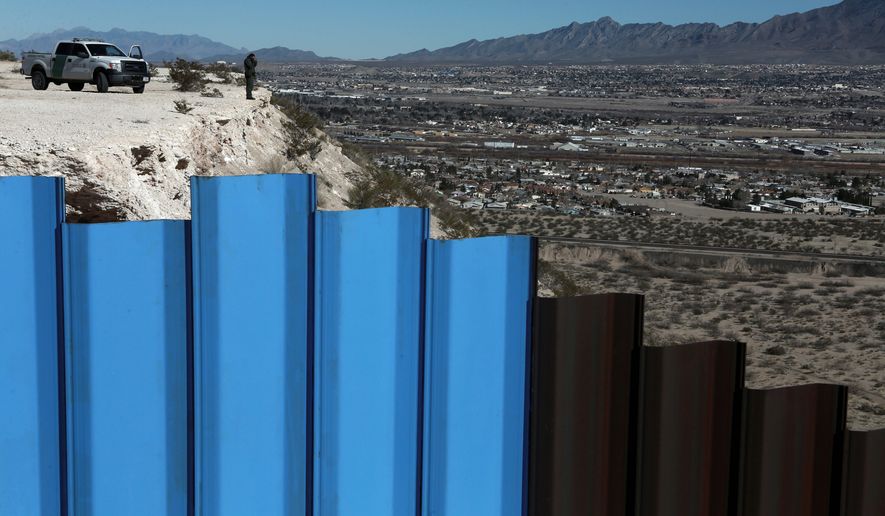Republican House leaders on Tuesday earmarked $1.6 billion to begin building President Trump’s border wall next year, including the money in their homeland security spending bill, setting up a fight with Democrats who have vowed to fight any funding for the wall, even if it means sending the federal government into a partial shutdown.
The spending bill also calls for 500 more Border Patrol agents, 1,000 more agents and officers to handle deportations from the interior of the U.S. and enough money to maintain an average of 44,000 detention beds to hold illegal immigrants.
The Republican bill also calls for adding more than two dozen jurisdictions to the 287(g) program, which allows local police and sheriff’s deputies to be trained to enforce immigration laws.
Combined, the stepped-up efforts are a down payment on Mr. Trump’s plans for a border wall and his call for a deportation force to oust illegal immigrants.
“Keeping Americans safe by protecting our homeland is a top priority,” said Rep. John R. Carter, Texas Republican and chairman of the House Homeland Security appropriations subcommittee. “This funding bill provides the resources to begin building a wall along our southern border, enhance our existing border security infrastructure, hire more Border Patrol agents and fund detention operations.”
The subcommittee will vote on the bill Wednesday and could send it to the floor for action later this month. Senators haven’t announced a bill, and it’s unclear whether they will find the money for the wall in their version.
But congressional Republicans are under pressure to deliver a border security funding win to Mr. Trump, and the $1.6 billion in the House bill fully meets his request for money to build 60 miles of new barriers in Texas — 32 miles of fencing and 28 miles of levee wall — and to replace 14 miles of fencing in San Diego. Those areas were deemed the highest priorities by U.S. Customs and Border Protection, the agency that oversees the Border Patrol.
Democrats have vowed to resist the spending and are still basking in a victory in the 2017 budget, in which they forced the president to back down on his call for $1 billion in fencing.
“Democrats will again draw a hard line against wasting taxpayer money to fulfill the president’s campaign applause line,” said Matthew Dennis, a spokesman for Appropriations Committee Democrats. “The purpose of the homeland security bill is to make communities more safe and secure, and this pointless wall does nothing to accomplish that.”
House Minority Leader Nancy Pelosi, California Democrat, said taxpayers shouldn’t have to pony up funds, particularly after Mr. Trump promised to make Mexico pay for the wall.
“President Trump’s immoral, ineffective and expensive wall is strongly opposed by Democrats and by many Republicans as well,” Mrs. Pelosi said. “A wall of bipartisan opposition is the only thing House Republicans are trying to build here.”
Mr. Trump last week, while meeting with Mexican President Enrique Pena Nieto on the sidelines of the Group of 20 summit, reaffirmed his desire to force Mexico to foot the bill.
But Homeland Security Secretary John F. Kelly didn’t broach the funding issue in his three-day trip to Mexico to meet with leaders last week.
Conservatives are adamant that the wall be funded. Rep. Mark Meadows, North Carolina Republican and an influential leader on the right, told Breitbart News that there are enough Republicans willing to shut down the government unless they get the money.
The Homeland Security Department is working on prototypes for a wall design and hopes to award contracts this fiscal year, which would set up construction for next year.
“It’s very clear we have a direction to secure the southern border. A wall and barrier is part of that process,” department spokesman David Lapan told reporters on Tuesday. “It is important for us to get the money.”
While the wall is likely to draw the most attention as a symbol of Mr. Trump’s campaign promise, the spending bill’s boost in detention beds, additional 287(g) jurisdictions and more personnel for U.S. Immigration and Customs Enforcement will have a bigger effect on illegal immigration.
Combined with policy changes, the new resources would mean agents have the permission and means to step up deportations of a far broader number of illegal immigrants from the interior of the U.S.
Mr. Trump’s get-tough stance has already had an effect on the flow of illegal immigrants across the southwestern border.
The number of people apprehended by the Border Patrol — a rough yardstick for the overall flow — is down more than 50 percent compared with this time last year.
Still, upticks were reported in May and June compared with February, March and April.
Mr. Lapan said immigration authorities are not worried because traffic usually rises in July and August and just seems to have come a little earlier this year.
“It’s not of concern because we do see season changes in migration coming across the border,” he said.
The numbers, though, show a different picture. Apprehensions have dropped every June and July for the previous four years. August has been mixed, with two years showing decreases and two years recording increases.
The spokesman said illegal immigrants should not get the wrong idea.
“The sense that people believe that once you get here, you’re home free — I think that message is getting out that that’s no longer the case,” Mr. Lapan said. “It’s more likely you’re going to be caught, it’s more likely you’re going to be returned.”
• Stephen Dinan can be reached at sdinan@washingtontimes.com.




Please read our comment policy before commenting.